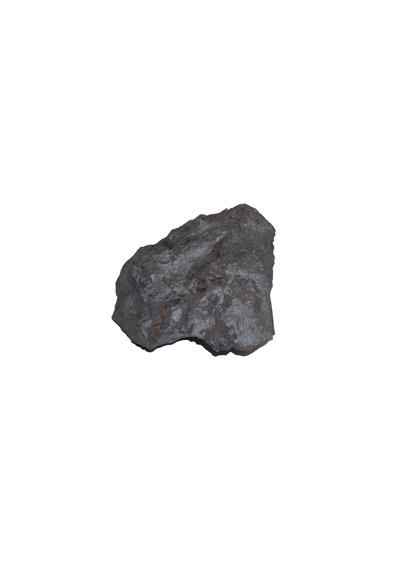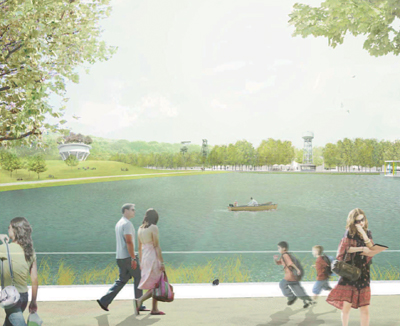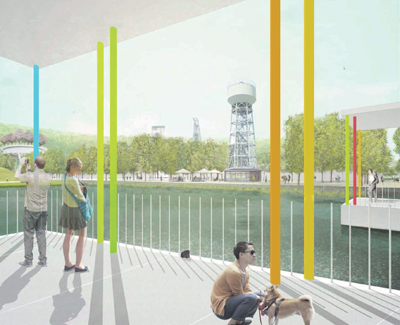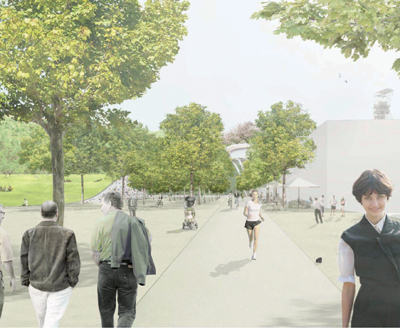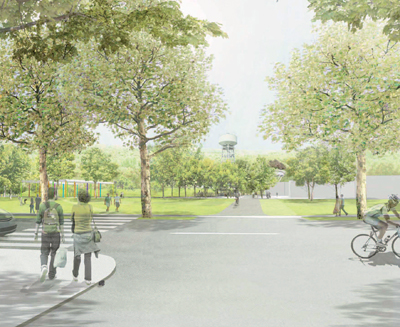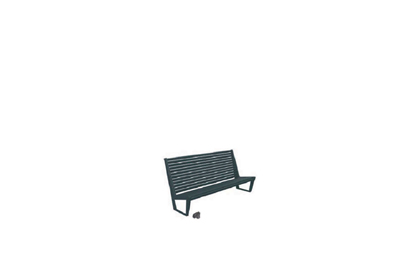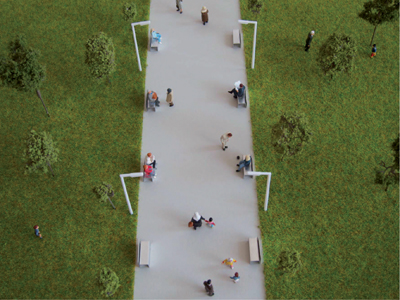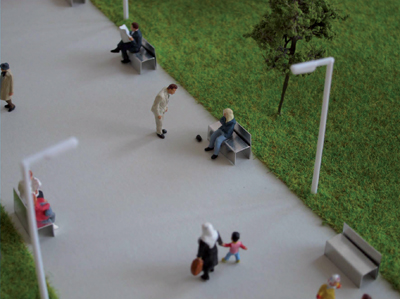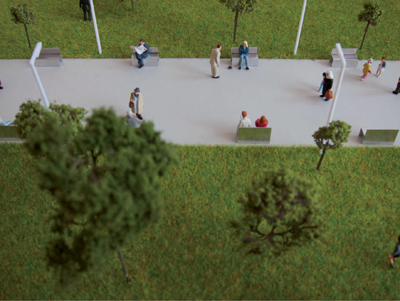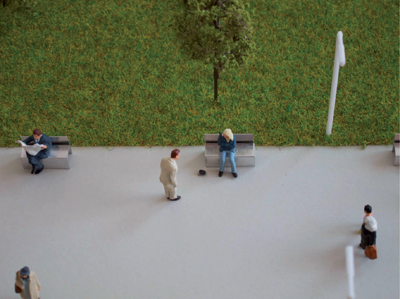Konzepttext:
The project:
The project consists of a bronze sculpture, in scale 1:1, of a piece of coal, painted with outdoor lasting lacquer to look exactly like a piece of coal. The sculpture would measure around 10 x 10 x 10 cm.
The piece should be placed on the pavement of one of the public spaces of the new park area as if after all the redevelopments and all the new plans for the area, the park, the new housing, the establishment of the Kreativ Quartier, one single piece of coal was left by an oversight. The foundation is below the pavement so nothing except the piece itself is visible.
The specific location will depend on the realization of the park area but it should be somewhere visible while not prominently so. It could be right next to or even under a bench, both to underline the idea of a piece left there more by coincidence than design, but also this placement would avoid accidents of people not noticing the small piece, fastened to the ground, and tripping over it.
It should be on a paved surface, along one of the major walkways or planned squares, in a busy and lively area. It should not be on grass as it would quickly disappear under grass and dirt. The visibility, although discreet, is crucial.
The concept:
The main idea of the piece is to create a public sculpture that is a memory of the previous uses of the area, a leftover from a different social, economic and physical space, still there, after all the new developments.
A small connection between past and present but one which tries to steer away from the pitfalls of either romanticizing or stigmatizing the past. Or the now.
In this sense the 1:1 scale and the realization of the bronze sculpture to look exactly like a piece of coal is a crucial point for the project. While very much playing on the traditional notions of public sculpture (a bronze sculpture of a historical past) by the simple act of the “casual” installation (no plinth, not at the center of a square) and the keeping of the scale it defies the classical temptations to make a romantic or heroic monument out of an ambivalent past or, as the other extreme, to stigmatize the same
past as the “hard times” that we have moved on from. It refuses to define and authorize the past, the present or the future. Instead by simply being there, looking like nothing but a piece of coal left behind, an element of one space entering the new, the associations of the piece will be simultaneously shared and personal, but not authoritative or defining. People‘s own thoughts of seeing a piece of coal will be the defining acts. Not a lesson and not a monument imposed on the place and the now but simply a leftover from a not so distant past, and with time an increasingly distant past. As a personal experience it will evoke different thoughts, feelings, memories and connotations in different people. Rather than trying to unify a space by a public sculpture, the piece insists on the notion that any space is, on the contrary, a complex ever evolving process of social, political, economic, personal and psychological interrelations.
Although the exact location can only be decided when the park begins to take form the placement is of huge importance to the project. As opposed to presenting a huge piece of coal on the top of the Halde or a plinth in a central square it will be a piece that you will in a way “only” see by accident. This however is the point, to avoid the connotations that would come by elevating, enlarging or centralizing the piece. It is thus not representative of one position, one past, one present or one future but many. Potentially as many as there are people who will see it. The object itself is a shared history. The meaning of it is however not confined in any way. These possible meanings are what‘s real.
That the sculpture nevertheless is a bronze sculpture is important, not only for reasons of durability. It opens for more ways of seeing and experiencing the piece.
It is important that it falls between this “accidental” placement while still being mentioned in public announcements of the projects in the park. That it is there as a public sculpture but that it retains an openness and ambivalence, and that the many people who will not read or hear about the art pieces in the park will also simply see it as a piece of coal that incredibly still lies there despite all the re-developments. Should they try and pick it up they will realize that it is something else of course. The
doubleness between a classic public bronze sculpture and a overseen tiny piece of one space into the next plays an important part.
By its very nature, or rather by its size and placement, many will never see the piece, many will never realize that it is there but this is a crucial part of the work and so to say the price paid for not imposing a specific position of power and meaning. It will be seen coincidentally out of the corner of the eye, as a piece of coal, with whatever connotations the person seeing it attaches to it.
Crucially, for the place and it‘s history as well as for this piece, knowing of it changes it.
For the piece this means the change in experience for people who, considering it a piece of coal, try to pick it up or anyone who will hear about the public sculptures and then decide to look for it. In this case, seeking it out as a sculpture, it will of course also be a comment on the attempts to claim authority by the classical public sculpture be it kings on horseback, heroic workers, abstract sculptures or something else entirely. Hopefully it will be encouraging thoughts on how to represent a place, a story, a history. Paradoxically the piece will even look like an abstract public sculpture had it only been a hundred times bigger.
It is also an insistence that something does not have to be spectacular to be important. That it does not have to be in your face, presented to or seen by everyone to have meaning. A hope that exactly this discreteness opens up the piece. The way of seeing is different if it‘s not put directly in front of you, if it is very likely to be overseen. A sort of fragile insistence. It is valuing openness, coincidence and ambivalence. In this sense it‘s also an admission of the impossibility to take the position of “explaining” the areas history, it‘s importance, it‘s me anings, to the people who have lived and worked here, or to the people who will visit, or come to live there in the future. It‘s a way of allowing the possibility to think about the past, the now and the future, from any possible position, personal, social
and political but without privileging one position over another. Dreaming under control of the object as the American writer Philip K. Dick once called it.
The meaning of the piece will change not only with individual viewers but obviously also with time. This is another crucial part. As the area changes, as the previous use of the area moves further into the past the piece will change too. It‘s about the importance of representing a past but the past as it is represented in the minds of people. Spaces change, different places arise. If one day no one thinks about coal anymore it will, so to say, turn into (a) stone. It claims no authority on what it is important to remember or forget. It‘s about opening up meanings rather than closing them down. At the same time though, it certainly and most importantly represents a common experience, place and history, but in
multitudes. It makes the space a place, a new space becomes a concrete place or rather; several overlapping places simultaneously.
In a way it‘s the simplest of interventions. A collage of superimposing one place onto another. What could, in Lohberg and the surrounding areas, be easier than to relate to a piece of coal in this place? However, what could be more complicated? Potentially this will be part of the area, of people‘s conception of the area. The work is the material, the site, the thoughts. It‘s what is absent and what is present and what is coming. A change in environment that is physical, social, economic, political, psychological and environmental. Times, spaces and places overlapping and not necessarily just going in one direction (forward). Instead it tries by it‘s very casualness and discreetness, it‘s very non-insistence to open up the space and refusing closure, since closure is also dominance.
With the work getting its significance through mental associations rather than through size and placement it tries to avoid the situation where a piece dominates a space, in a sense being so small and discreet that it is only there when it means something to someone, individuals as well as groups.
Included are visualizations, using the drawings of the landscape architects Lohrer Hochrein, and some of their photo examples
of types of benches.
These images hopefully give a good idea of the principle, but as they are not of the exact scenes where the sculpture should actually be placed the 3D model that I have included with this proposal should give another view and one more in line with my suggestion for placement.
I would suggest to take this 3D model as the prime reference but hope that the combination of the different visualizations give a more elaborate overview of the project.
Beurteilung des Fachbeirats:
Jakob Kolding
(Ohne Titel)
Der kleine Kohlestein aus Bronze von Jakob Kolding gefiel dem Fachbeirat unter Aspekten wie Irritation, Überraschung, Verwunderung und zugleich als sensibles, mit Charme konzipiertes Mini-Element der großen Sache "Kohle". Die Verwendung eines haushaltsüblichen Stücks im Gegensatz zum Untertage gebrochenen Steinkohlebrocken wurden positiv diskutiert. Diese Arbeit macht unter allen Gesichtspunkten großen Sinn und Freude und wird auch dank der kostengünstigen Produktion unbedingt zur Realisierung empfohlen.
Zur Realisierung empfohlen
